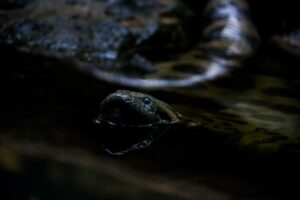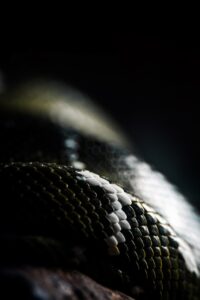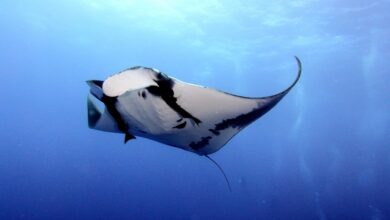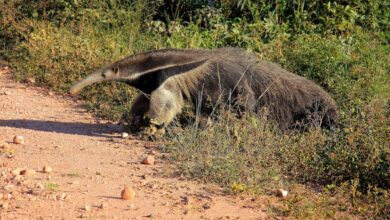The Famous And Huge Green Anaconda
The anaconda is one of the most well-known snakes in the world. It is famous for its enormous size and lives in tropical South America. The term “anaconda” refers to a group of snakes, but we always use it to refer to just one species, the green anaconda, also known as the common anaconda.
tropical South America. The term “anaconda” refers to a group of snakes, but we always use it to refer to just one species, the green anaconda, also known as the common anaconda.
The green anaconda is the world’s heaviest snake, weighing 250kg (550lbs), but the reticulated python is the world’s longest snake. This species is found in South America and lives near water in much of the continent’s northern regions.
They are carnivores, and because they are non-venomous, they will seize prey with their mouth and then tie around it to squeeze it until it stops breathing. They can take large prey such as deer or tapirs, but this is rare. Because of their large size, green anacondas are frequently persecuted. Another threat is habitat destruction and vehicle strikes.
Appearance
Green anacondas are well-known for being the world’s largest and heaviest snake. However, Green anacondas do not hold the record for the longest snake, which the reticulated python owns. They have grown 8.8m (29ft) long and weigh 250kg (550lbs). Their circumference can reach 30.5cm (12in). Males are significantly smaller than females.
They have olive-green skin with black marks on them. An orange-yellow stripe runs down the side of their narrow head. The eyes and nostrils of green anacondas are located high on the head. This allows them to hide in the water while still being able to see and breathe.
Anaconda Diet
Anacondas are carnivorous animals. It feeds on anything it can conquer. This includes everything from birds, mammals, reptiles, and fish to larger prey like tapirs, capybaras, deer, and caimans. It is unusual to consume such a large prey item.
Cannibalism has been observed in some cases, with females eating relatively small males. Scientists believe this is an opportunism move after birth to meet their energy requirements during the long gestation period.
To kill their prey, they will use their muscular body to constrict them. The prey is frequently dragged into the water, which is thought to help them manoeuvre their food into the proper position. After a large meal, they may not eat for months. Their teeth curve backward to help them grip prey.
A green anaconda’s mouth can expand to almost three times the size of its head. This enables them to consume larger prey than one might expect. These snakes are thought to be among the few that can eat humans. Despite this, reports of them attacking humans are uncommon.
Habitat
Green anacondas live in tropical savannas, grasslands, and rainforests. They’re also common in swamps and marshes. Green anacondas prefer slow-moving bodies of water. They spend much time near water, such as streams, rivers, and flooded grassland.
Reproduction
During the dry season, the breeding season lasts from March to May. Female green anacondas keep moving around for this time, preferring to wait for males to approach. Many males will come for a single female by leaving a scent trail to find her. Occasionally, up to 12 males will compete for a single female. These males form a “breeding ball” around the female. They will then all attempt to mate with the female, which could take up to four weeks. Female green anacondas may eat their mate after mating to obtain the energy she requires during their pregnancy.
This species can give birth through parthenogenesis. This involves the female fertilizing her eggs, eliminating her need to mate with a male. Unlike most snakes, which lay eggs, the young are born alive six to seven months after mating. A typical clutch consists of 20 to 40 anacondas. These young develop inside a membrane, which they emerge from after birth. They are 70-80cm (27.5-31.5in) long at birth. They take off after birth and are responsible for looking after themselves. Because they are vulnerable to predation, they usually start by hiding. A green anaconda will proliferate until sexual maturity at the age of six years. After maturity, growth continues, albeit at a slower rate.
Anaconda Behavior
Green anacondas are nocturnal creatures. Green anacondas spend the majority of their time in the water. Where the savanna floods seasonally, these snakes will seek water or bury themself in the mud while it is dry. These animals can detect their prey using their tongue, which picks up chemical signals. Green anacondas are considered solitary because they prefer to hunt alone.
Predators and Threats
Green anacondas have no natural predators other than humans as adults, but juveniles face a variety of predators. They may burrow into the mud, flee to the water, or curl up into a ball when threatened. This protects the head while still allowing them to strike. The green anaconda is currently considered locally common throughout much of its range, but the current population trend has not been determined.
They are suffering from habitat loss and degradation due to the construction of hydroelectric dams. Oil drilling is also done in parts of their range. Vehicle strikes have killed green anacondas in some areas. Some are captured and turned into leather, while others may be used in traditional medicines.




